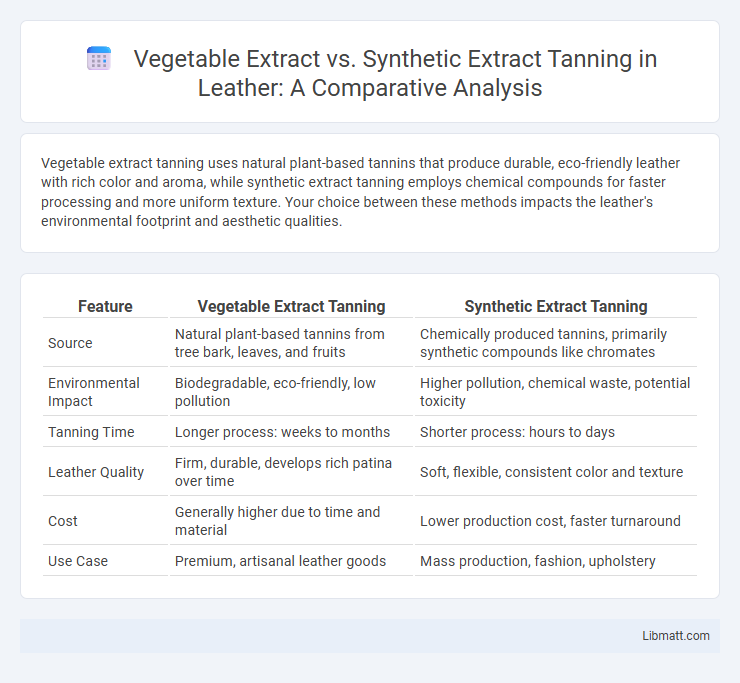Vegetable extract tanning uses natural plant-based tannins that produce durable, eco-friendly leather with rich color and aroma, while synthetic extract tanning employs chemical compounds for faster processing and more uniform texture. Your choice between these methods impacts the leather's environmental footprint and aesthetic qualities.
Table of Comparison
| Feature | Vegetable Extract Tanning | Synthetic Extract Tanning |
|---|---|---|
| Source | Natural plant-based tannins from tree bark, leaves, and fruits | Chemically produced tannins, primarily synthetic compounds like chromates |
| Environmental Impact | Biodegradable, eco-friendly, low pollution | Higher pollution, chemical waste, potential toxicity |
| Tanning Time | Longer process: weeks to months | Shorter process: hours to days |
| Leather Quality | Firm, durable, develops rich patina over time | Soft, flexible, consistent color and texture |
| Cost | Generally higher due to time and material | Lower production cost, faster turnaround |
| Use Case | Premium, artisanal leather goods | Mass production, fashion, upholstery |
Introduction to Vegetable and Synthetic Extract Tanning
Vegetable extract tanning utilizes natural tannins derived from plant sources such as tree bark, leaves, and fruits, offering an eco-friendly alternative with biodegradable properties. Synthetic extract tanning involves chemical compounds engineered to mimic natural tannins, providing faster processing times and uniformity in leather quality. Both methods aim to transform raw hides into durable, flexible leather, with vegetable tanning emphasizing sustainability and synthetic tanning focusing on efficiency and consistency.
What Are Vegetable Extracts in Tanning?
Vegetable extracts in tanning are natural compounds derived from tree bark, leaves, fruits, and roots, commonly used to convert animal hides into leather through a process called vegetable tanning. These extracts contain tannins, polyphenolic molecules that bind to collagen proteins in hides, enhancing durability, flexibility, and water resistance without harmful chemicals. You benefit from vegetable tanning by receiving eco-friendly, biodegradable leather with unique textures and colors not achievable through synthetic extracts.
What Are Synthetic Extracts in Tanning?
Synthetic extracts in tanning refer to chemically formulated substances designed to mimic natural plant extracts' tanning properties, offering consistent quality and faster processing times compared to traditional vegetable extracts. These synthetic extracts often contain specific active compounds like tannins synthesized in laboratories, providing controlled and uniform results for leather tanning. Your choice between synthetic and vegetable extracts depends on desired leather characteristics, sustainability goals, and production efficiency.
Historical Perspectives: Traditional vs Modern Tanning Methods
Traditional tanning methods relied heavily on vegetable extracts derived from tree bark, leaves, and other plant materials, valued for their natural tannins and environmental sustainability. Modern tanning frequently uses synthetic extracts, engineered for faster processing, consistent results, and enhanced leather durability. Understanding the historical shift from vegetable to synthetic extracts helps you appreciate the balance between eco-friendly practices and industrial efficiency in today's leather production.
Raw Materials: Sourcing and Sustainability
Vegetable extract tanning utilizes natural raw materials such as tannins derived from tree barks, leaves, and fruits, which are renewable and biodegradable, promoting sustainable forestry practices. Synthetic extract tanning relies on chemically synthesized compounds often derived from petrochemical sources, raising concerns about environmental impact and resource depletion. Sustainable sourcing in vegetable extracts supports circular economy principles, while synthetic alternatives may demand greater energy inputs and generate hazardous waste.
Environmental Impact: Vegetable vs Synthetic Extracts
Vegetable extract tanning uses natural plant-based materials like tannins from tree bark, resulting in lower environmental pollution and better biodegradability compared to synthetic extract tanning, which often relies on chemical compounds that can release harmful pollutants and heavy metals into water sources. The vegetable method reduces the carbon footprint and minimizes toxic waste, promoting sustainable leather production with less soil and water contamination. Choosing vegetable extract tanning supports eco-friendly practices that protect ecosystems and reduce your leather product's environmental impact.
Leather Quality and Characteristics
Vegetable extract tanning uses natural tannins derived from tree bark, producing leather with a rich, firm texture that develops a unique patina over time, enhancing durability and aesthetic appeal. Synthetic extract tanning relies on chemical compounds, resulting in more uniform leather that is often softer and more resistant to water and stains but lacks the depth and character of vegetable-tanned leather. Your choice between vegetable and synthetic extracts significantly impacts the leather's quality, appearance, and longevity, tailoring the material to specific uses and preferences.
Economic Considerations in Tanning Industries
Vegetable extract tanning relies heavily on natural raw materials like quebracho, mimosa, and valonea, which can be cost-effective but subject to supply fluctuations and seasonal availability, impacting overall production expenses. Synthetic tanning agents, such as chromium salts and aldehydes, offer more consistent pricing and supply stability, reducing economic risks and enhancing large-scale production efficiency. However, the environmental compliance costs associated with synthetic tanning waste management often increase operational expenses compared to more sustainable vegetable tanning processes.
Health and Safety Concerns
Vegetable extract tanning uses natural plant-based tannins, offering lower toxicity and reduced environmental impact compared to synthetic extracts often containing harmful chemicals like chromium. Your skin and respiratory health benefit from fewer allergic reactions and irritants when vegetable extracts are used in leather processing. Choosing vegetable extracts supports safer workplace conditions by minimizing exposure to hazardous substances commonly found in synthetic tanning agents.
Future Trends: Innovations in Tanning Extracts
Future trends in tanning extracts emphasize the development of sustainable and eco-friendly vegetable extracts enriched with natural antioxidants and bioactive compounds to enhance leather quality and durability. Advancements in biotechnology enable the production of synthetic extracts that mimic natural tannins while reducing environmental impact and improving consistency in tanning processes. Innovations include combining plant-based polyphenols with engineered enzymes to create hybrid tanning agents that optimize efficiency and minimize chemical waste.
Vegetable extract vs synthetic extract tanning Infographic

 libmatt.com
libmatt.com